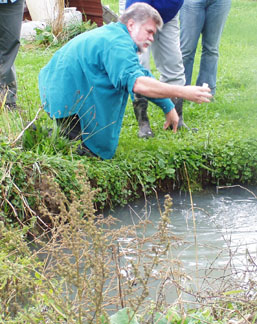CU researchers get grant to find ways to prevent phosphorus pollution in New York City's third-largest reservoir
By Susan Lang
The Cannonsville watershed in the Catskills region of New York state, one of nine reservoirs that provide drinking water to some 9 million people in and near New York City, is under attack from phosphorus runoff form urban and rural sources.
To identify the best ways to reduce the polluting impact of phosphorus in the Cannonsville watershed, two researchers at Cornell University, the land-grant institution of New York state, have been awarded nearly $1 million over three years from the Cooperative State Research, Education and Extension Service, U.S. Department of Agriculture (USDA).

Because the Cannonsville watershed reflects the distinctive topographic and hydrologic characteristics of watersheds throughout the Northeast, the work will be applicable not only to the New York City watershed but also to the watersheds of Lake Champlain, Skaneateles Lake and the Chesapeake Bay.
However, management practices to reduce phosphorus runoff, which were mostly developed in the Midwest, have not been adequately tested scientifically. Although New York City Department of Environmental Protection and the other agencies that manage water resources have promoted various best management practices (BMPs) to control phosphorus runoff into water supply streams and reservoirs, researchers are not sure what combination of these practices are most cost effective.
The Cornell researchers will compile a database of many recommendations and evaluate combinations of BMPs. "Using modeling to evaluate phosphorus transport in watersheds, statistical inference and extensive sources of data, which detail farm, field, date, cost and type of each BMP implemented in the watershed since the 1990s, we will quantify the effectiveness of BMPs in New York and the Northeast," said Tammo Steenhuis, professor of biological and environmental engineering, a co-investigator on the project.
"Then we will rank the BMPs and develop methods that can be used to incorporate the most cost-effective BMPs in whole farm plans," added Christine Shoemaker, professor of civil and environmental engineering and the other co-investigator. The researchers also will develop an extensive Web site with links to available maps, monitoring data and model predictions.
Both researchers have been working extensively in the Cannonsville watershed and between them have expertise in hydrology, water-quality modeling, statistical analysis, field experimentation, environmental systems analysis, optimization and economics. The research team also includes additional specialists in statistics, economics, agronomy, animal science and farm management.
The Cannonsville basin is the third-largest reservoir in New York City's water supply system. The excessive phosphorus runoff into the Cannonsville watershed not only threatens the quality of New York City's drinking water but also has led to wastewater discharge restrictions in the Cannonsville area that could limit economic development in local communities, Steenhuis said.
He and Shoemaker will work closely with the New York State Watershed Agricultural Council, Watershed Agricultural Program, USDA-Agricultural Research Service at Pennsylvania State University, New York City Department of Environmental Conservation, Cornell Cooperative Extension, Natural Resources Conservation Service, local soil and water conservation districts and county planners.
The research is affiliated with Cornell's Center for the Environment, a Cornell-wide unit specializing in crafting interdisciplinary collaborations among Cornell researchers and partnering institutions to apply new knowledge to environmental problems and needs around the world.
Media Contact
Get Cornell news delivered right to your inbox.
Subscribe